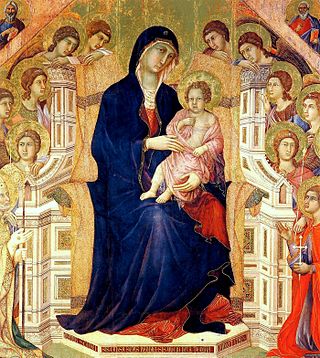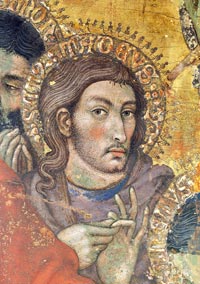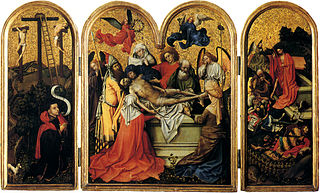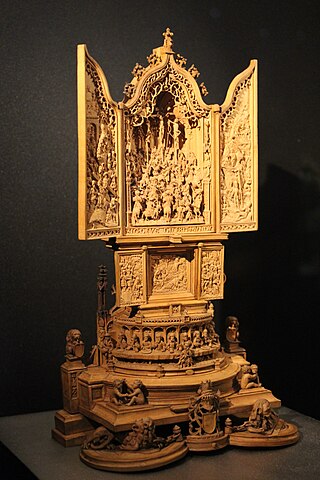
Duccio di Buoninsegna, commonly known as just Duccio, was an Italian painter active in Siena, Tuscany, in the late 13th and early 14th century. He was hired throughout his life to complete many important works in government and religious buildings around Italy. Duccio is considered one of the greatest Italian painters of the Middle Ages, and is credited with creating the painting styles of Trecento and the Sienese school. He also contributed significantly to the Sienese Gothic style.

Antonello da Messina, properly Antonello di Giovanni di Antonio, but also called Antonello degli Antoni and Anglicized as Anthony of Messina, was an Italian painter from Messina, active during the Italian Early Renaissance.

Robert Campin, now usually identified with the Master of Flémalle, was a master painter who, along with Jan van Eyck, initiated the development of early Netherlandish painting, a key development in the early Northern Renaissance.

Lorenzo Lotto was an Italian Renaissance painter, draughtsman, and illustrator, traditionally placed in the Venetian school, though much of his career was spent in other north Italian cities. He painted mainly altarpieces, religious subjects and portraits. He was active during the High Renaissance and the first half of the Mannerist period, but his work maintained a generally similar High Renaissance style throughout his career, although his nervous and eccentric posings and distortions represented a transitional stage to the Florentine and Roman Mannerists.

Pietro Lorenzetti or Pietro Laurati was an Italian painter, active between c. 1306 and 1345. Together with his younger brother Ambrogio, he introduced naturalism into Sienese art. In their artistry and experiments with three-dimensional and spatial arrangements, the brothers foreshadowed the art of the Renaissance.

Pietro Perugino, an Italian Renaissance painter of the Umbrian school, developed some of the qualities that found classic expression in the High Renaissance. Raphael became his most famous pupil.

Dieric Bouts was an Early Netherlandish painter. Bouts may have studied under Rogier van der Weyden, and his work was influenced by van der Weyden and Jan van Eyck. He worked in Leuven from 1457 until his death in 1475.

Taddeo di Bartolo, also known as Taddeo Bartoli, was an Italian painter of the Sienese School during the early Renaissance. His biography appears in the Vite of Giorgio Vasari, who claims that Taddeo was the uncle of Domenico di Bartolo.

Bernardo Daddi was an early Italian Renaissance painter and the leading painter of Florence of his generation. He was one of the artists who contributed to the revolutionary art of the Renaissance, which broke away from the conventions of the preceding generation of Gothic artists, by creating compositions which aimed to achieve a more realistic representation of reality. He was particularly successful with his small-scale works and contributed to the development of the portable altarpiece, a format that subsequently gained great popularity.

St. John on Patmos is an oil on panel painting by the Netherlandish artist Hieronymus Bosch, created c. 1489. The painting is held in the Gemäldegalerie, in Berlin, Germany. The reverse is also painted, the title of that picture is Scenes from the Passion of Christ and the Pelican with Her Young.

Bartolo di Fredi, also called Bartolo Battiloro, was an Italian painter, born in Siena, classified as a member of the Sienese School.

Lippo Memmi was an Italian painter from Siena. He was the foremost follower of Simone Martini, who was his brother-in-law.
The decade of the 1450s in art involved many significant events, especially in sculpture.

The Master of the Virgo inter Virgines was an Early Netherlandish painter and designer of woodcuts active around Delft between 1483 and 1498. He is named for The Virgin and Child with Four Holy Virgins, an altarpiece of the Virgin with Saints Catherine, Cecilia, Ursula, and Barbara which formerly hung in the convent of Konigsveld, but which is now in the Rijksmuseum in Amsterdam. He was first distinguished individually in 1903; based upon the style of the altarpiece a considerable body of work has since been built up. The Master has been described as the most uncompromisingly "realist" of his contemporaries, and not at all concerned with elegance; he has also been called a forerunner of the Dutch school of painting.

Jean Malouel, or Jan Maelwael in his native Dutch, was a Dutch artist who was the court painter of Philip the Bold, Duke of Burgundy and his successor John the Fearless, working in the International Gothic style.

The Entombment is a glue-size painting on linen attributed to the Early Netherlandish painter Dieric Bouts. It shows a scene from the biblical entombment of Christ, and was probably completed between 1440 and 1455 as a wing panel for a large hinged polyptych. While the altarpiece remains lost as a complete set, it is thought to have contained a central crucifixion scene flanked by four wing panel works half its height – two on either side – depicting scenes from the life of Christ. The smaller flanking panels would have been paired in a format similar to Bouts's 1464–1468 Altarpiece of the Holy Sacrament. The larger work was probably commissioned for export to Italy, possibly to a Venetian patron whose identity is lost. The Entombment was first recorded in a mid-19th-century inventory in Milan, and has been in the National Gallery, London, since its purchase on the Gallery's behalf by Charles Lock Eastlake in 1861.

The Seilern Triptych, variously dated c. 1410-15 or c. 1420–25, is a large oil and gold leaf on panel, fixed winged triptych altarpiece generally attributed to the Early Netherlandish painter Robert Campin. It is the earliest of two known triptychs attributed to him, although the outer wing panels paintings are lost. The work details the events of Christ's passion; with iconography associated with the liturgy of Holy Week. The panels, which should be read from left to right, detail three stations of the cycle of the Passion of Jesus; the crucifixion, the burial and the resurrection.

The miniature altarpiece in the British Museum, London, is a very small portable Gothic boxwood miniature sculpture completed in 1511 by the Northern Netherlands master sometimes identified as Adam Dircksz, and members of his workshop. At 25.1 cm (9.9 in) high, it is built from a series of architectural layers or registers, which culminate at an upper triptych, whose centre panel contains a minutely detailed and intricate Crucifixion scene filled with multitudes of figures in relief. Its outer wings show Christ Carrying the Cross on the left, and the Resurrection on the right.


























